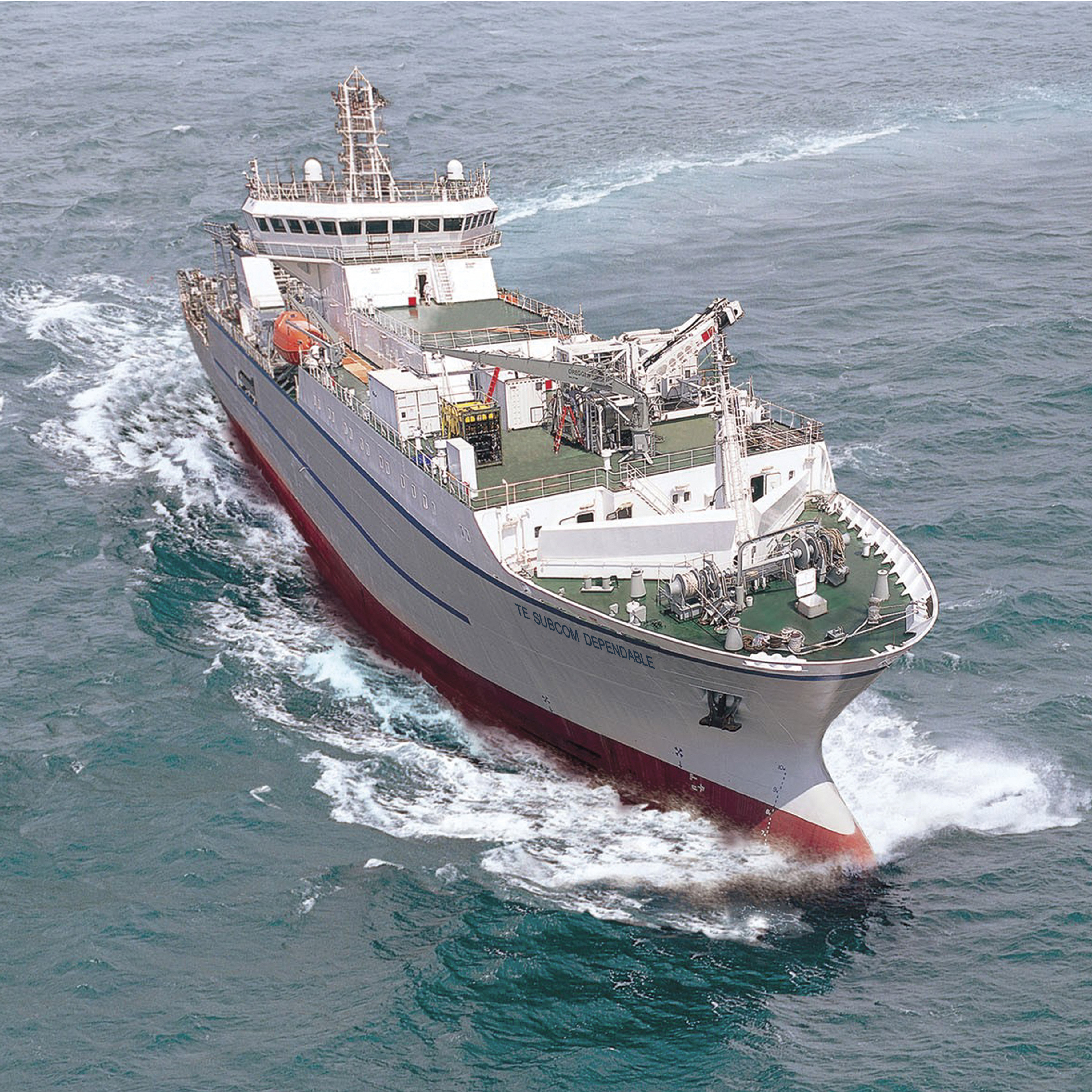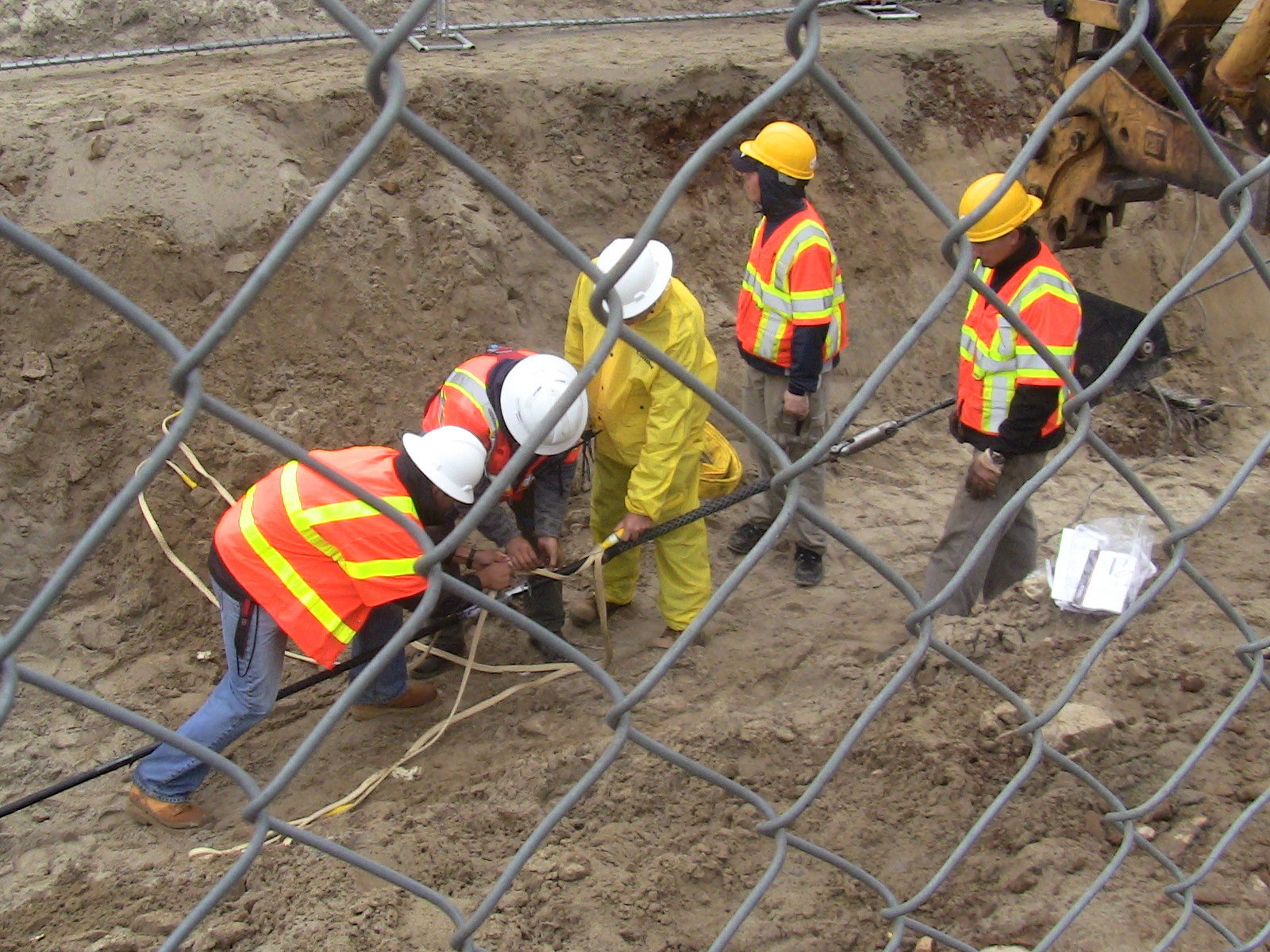Ocean Observatories Initiative Cable Connects to Bring Ocean Data to Shore
JULY 15 UPDATE FROM PACIFIC CITY: The Ocean Observatories Initiative (OOI) program on July 12, 2011, connected the first undersea cable that will link scientists and others on land to data streaming from an extensive array of next-generation sensors located in the ocean and on the seafloor, marking progress in construction of the first U.S. regional cabled ocean observatory. Shown in this photo, the first of two submarine cables is pulled to shore. That cable extends to a study site at Hydrate Ridge, approximately 75 miles off the coast of Pacific City, Oregon, and loops back on the continental shelf to the link cable moorings of the Coastal Scale Nodes Oregon Line along with the OOI Endurance Array site. A second cable was pulled to shore Friday, July 15. That cable extends 310 miles west to the Axial Seamount study site on the Juan de Fuca Ridge. Each primary instrumented site will offer two-way communication between land and sea and will be supplied with up to 10 gigabits per second of telecommunications bandwidth and 8 kilowatts of power. Data will be collected from the sea surface to the seafloor and transmitted to shore in near-real time via the Internet. To read the full story on cable installation click here. To track the daily progress of the installation visit the University of Washington RSN blog here.

(Click to enlarge) The OOI program on July 12, 2011, connected the first undersea cable that will link scientists and others on land to data streaming from an extensive array of next-generation sensors located in the ocean and on the seafloor. Shown in this photo, the first of two submarine cables is pulled to shore.
Click on thumbnails above to enlarge photos. Photos provided by Kerry Beck of the OOI Program.
The Ocean Observatories Initiative (OOI) program is installing the undersea cable that will link scientists and others on land to data streaming from an extensive array of next-generation sensors located in the ocean and on the seafloor, marking progress in construction of the first U.S. regional cabled ocean observatory.
The OOI, a program funded by the National Science Foundation, is planned as a networked infrastructure of sensor systems that will address vital science questions by measuring physical, chemical, geological and biological variables of the ocean.
The Regional Scale Nodes (RSN) component of the OOI establishes an interactive network of ocean observing sensors, instruments, and moorings in the Northeast Pacific ocean connected by 900 kilometers (~ 560 miles) of electro-optical cable and designed to operate continuously for 25 years.
During the installation process, the fiber-optic cable is placed on the ocean floor by a commercial cable ship, the TE Subcom Dependable. This week the cable was pulled ashore through a previously installed conduit and was “landed” on the beach at Pacific City, Ore., where it will be connected to a shore station located one mile north. Remaining at-sea installation will take place through much of August.
The cabled network features two submarine cables extending from the shore station to two main study sites: one cable reaches Hydrate Ridge, approximately 120 kilometers (~75 miles) to the southwest of Pacific City, and loops back on the continental shelf to link cabled moorings of the Coastal Scale Nodes Oregon Line along the OOI’s Endurance Array site. The second cable extends 500 kilometers (~ 310 miles) west to the Axial Seamount study site on the Juan de Fuca Ridge. Each primary instrumented site will offer two-way communication between land and sea and will be supplied with up to 10 gigabits per second of telecommunications bandwidth and 8 kilowatts of power. Data will be collected from the sea surface to the seafloor and transmitted to shore in near-real time via the Internet.
“With the landing of the OOI undersea cable we see connection of a tangible piece of the OOI’s unique infrastructure that will bring to shore data from multiple sensors and instruments and change the way we conduct ocean observation for decades to come,” said Tim Cowles, Vice President & Director of Ocean Observing at the Consortium for Ocean Leadership. “This is a significant step forward in the construction of the OOI and moves us closer to our goal of providing the sustained observations needed to help us better understand and manage our oceans.”
The OOI will provide research scientists, educators, students and the public with unparalleled access to the physical, chemical, geological and biological phenomena of the ocean. Sustained ocean observations and interactions that span decades rather than days will allow ocean exploration and discovery to move into previously unimaginable realms. Greater knowledge of the ocean’s interrelated systems is vital for increased understanding their effects on biodiversity, ocean and coastal ecosystems, ecosystem health and climate change.
According to John R. Delaney, Director and Principal Investigator of the OOI Regional Scale Nodes and University of Washington Professor of Oceanography, the study sites selected off the Oregon Coast offer a representative suite of natural phenomena that occur throughout the world’s oceans and seafloors. “The OOI regional cabled network will enable scientists to conduct local investigations of such global processes as climate-influencing ocean currents, active earthquake zones, creation of new seafloor, and rich environments of marine plants and animals.”
Progress on this component of the OOI has been taking place for many months. In March 2011 the program completed the Horizontal Directional Drilling (HDD) process necessary to install the power and data undersea cable at Pacific City. HDD is a common technique used to install cables, pipelines, fiber-optic ducts and other types of buried infrastructure under environmentally sensitive areas or technically difficult sites. The first step in the HDD process involved drilling under the beach and surf zone to install two horizontal sub-sea bed conduits running from the beach to an offshore location so that the two cables will remain buried from the offshore location to the beach manhole.
The University of Washington is leading the OOI cabled component effort and has contracted with L3 MariPro Inc., Goleta, Calif., for the design and build of the OOI RSN primary infrastructure.
The OOI Program is managed and coordinated by the OOI Project Office at the Consortium for Ocean Leadership, in Washington, D.C., and is responsible for construction and initial operations of the OOI network.
In addition to University of Washington, three other Implementing Organizations are responsible for construction and development of the overall program. Woods Hole Oceanographic Institution and its partners, Oregon State University and Scripps Institution of Oceanography, are responsible for the coastal and global moorings and their autonomous vehicles. The University of California, San Diego, is implementing the cyberinfrastructure component. Rutgers, the State University of New Jersey, with its partners University of Maine and Raytheon Mission Operations and Services, is responsible for the education and public engagement software infrastructure.
About the Consortium for Ocean Leadership
The Consortium for Ocean Leadership is a Washington, DC-based nonprofit organization that represents 95 of the leading public and private ocean research and education institutions, aquaria and industry with the mission to advance research, education and sound ocean policy. The organization also manages ocean research and education programs in areas of scientific ocean drilling, ocean observing, ocean exploration, and ocean partnerships.
About the Regional Scale Nodes
Each primary instrumented site on the RSN will offer two-way communication between land and sea, and will be supplied with up to ten gigabits per second of telecommunications bandwidth and eight kilowatts of power. Data will be collected from the sea surface to the seafloor and transmitted to the Internet in near-real time. This cabled component of the OOI addresses two major themes: 1) the provision of power and bandwidth to empower and develop a host of exciting new and rapidly developing technologies; and 2) a sustained, long-term and distributed presence throughout the ocean for decades.
For more OOI program news, updates, and photos visit: www.oceanobservatories.org and www.interactiveoceans.washington.edu.
For more information or to request interviews, contact:
Kerry Beck
Director of Communications, Ocean Observatories Initiative
Consortium for Ocean Leadership
Office: (202) 787-1685
Cell: (202) 538-0099
kbeck@oceanleadership.org
www.oceanobservatories.org
Nancy Penrose
Communications Coordinator for Ocean Observatories Initiative
University of Washington
Office: (206) 221-5781
Cell: (425)753-0623
Penrose@ocean.washington.edu


